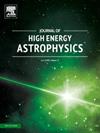Search for very high energy gamma-ray emission from a sample of high redshift blazars with MACE
IF 10.2
4区 物理与天体物理
Q1 ASTRONOMY & ASTROPHYSICS
引用次数: 0
Abstract
Blazars, a subclass of face-on jetted active galactic nuclei, are the most persistent and powerful sources of cosmic gamma-rays in the Universe. They represent a dominant population of gamma-ray sources, spread all over the sky with known and unknown redshifts up to z ∼ 6 (e.g. Belladitta et al. (2020)). Detection of more than 3500 blazars by the space-based Fermi-Large Area Telescope (LAT) in the high energy (HE, above 100 MeV) band reveals that a significant amount of power carried by the relativistic plasma jets in blazars is dissipated at gamma-ray energies. However, a small fraction of only less than 3% are detected at very high energies (VHE, above 30 GeV) by the ground-based Cherenkov telescopes. Therefore, their detection at the highest possible energies is extremely important to understand the blazar-phenomenon in the Universe. In this paper, we report observational results obtained from the recent monitoring of the six high redshift () blazars with the Major Atmospheric Cherenkov Experiment (MACE) in the energy range above ∼ 80 GeV. No statistically significant detection of the sources is found. Thus, for the null detections, we estimate 99% confidence level upper limit on the integral flux for the individual sources and use the Fermi-LAT measurements to constrain their gamma-ray emission behavior.
用MACE从高红移耀变体样本中寻找高能伽马射线发射
耀变体是正面喷射的活动星系核的一个子类,是宇宙中最持久、最强大的宇宙伽马射线源。它们代表了伽玛射线源的主要种群,分布在整个天空中,已知和未知的红移高达z ~ 6(例如Belladitta等人(2020))。基于太空的费米大面积望远镜(LAT)在高能(HE, 100 MeV以上)波段探测到3500多个blazars,揭示了blazars中相对论性等离子体射流所携带的大量能量以伽马射线能量的形式耗散。然而,只有不到3%的一小部分被地面切伦科夫望远镜在非常高能量(VHE,超过30 GeV)下探测到。因此,在尽可能高的能量下探测它们对于理解宇宙中的耀变体现象是极其重要的。在本文中,我们报告了最近用主要大气切伦科夫实验(MACE)在能量范围高于~ 80 GeV的6个高红移(z>0.3)耀变体的观测结果。没有发现有统计学意义的源检测。因此,对于零探测,我们估计了单个源积分通量的99%置信水平上限,并使用费米- lat测量来约束它们的伽马射线发射行为。
本文章由计算机程序翻译,如有差异,请以英文原文为准。
求助全文
约1分钟内获得全文
求助全文
来源期刊

Journal of High Energy Astrophysics
Earth and Planetary Sciences-Space and Planetary Science
CiteScore
9.70
自引率
5.30%
发文量
38
审稿时长
65 days
期刊介绍:
The journal welcomes manuscripts on theoretical models, simulations, and observations of highly energetic astrophysical objects both in our Galaxy and beyond. Among those, black holes at all scales, neutron stars, pulsars and their nebula, binaries, novae and supernovae, their remnants, active galaxies, and clusters are just a few examples. The journal will consider research across the whole electromagnetic spectrum, as well as research using various messengers, such as gravitational waves or neutrinos. Effects of high-energy phenomena on cosmology and star-formation, results from dedicated surveys expanding the knowledge of extreme environments, and astrophysical implications of dark matter are also welcomed topics.
 求助内容:
求助内容: 应助结果提醒方式:
应助结果提醒方式:


